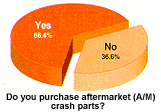As a shop owner, you know where you’re spending your money (at least you’d better), but have you ever wondered how other shop owners are spending theirs? Do they spend about the same amount of money on equipment, parts and supplies as you? Are they buying fewer aftermarket (A/M) crash parts since the State Farm trial verdict and using more used parts? If they’re still buying A/M crash parts, is it because they like them or because they feel pressured to buy them?
These questions and many more are answered in our 2000 Purchasing Profile.
|
What types of equipment do you have or plan to purchase in the next 12 months? |
||
|
Type of Equipment |
Percent Owning |
Plan to Purchase |
|
Computerized measuring system |
33.7% |
14.4% |
|
Computerized estimating system |
67.3% |
14.4% |
|
Above-ground lift |
50.5% |
11.9% |
|
Below-ground lift |
11.8% |
.0% |
|
Portable lift |
41.6% |
8.9% |
|
Central vacuum system |
9.9% |
18.8% |
|
Downdraft booth |
48.5% |
19.2% |
|
Prep station |
21.7% |
12.4% |
It’s interesting to note that in 1995:

• 5% of respondents owned a computerized measuring system;
• 38.3% owned a computerized estimating system;
• 32% owned an above-ground lift;
•13.7% owned a below-ground lift (less own one today);
• 33.7% owned a portable lift;
• 9.7% owned a central vacuum system;
•30% owned a downdraft spraybooth;
•16% owned a prep station.
|
What do you spend each month on the following items? |
||
|
Average |
Median |
|
|
Surface prep materials |
$551 |
$150 |
|
Primers |
$502 |
$300 |
|
Fillers |
$147 |
$95 |
|
Masking products |
$551 |
$150 |
|
Abrasives |
$292 |
$200 |
|
Paint |
$2,929 |
$1,000 |
|
Because averages are often skewed due to larger shops and their volume, another measure of what a shop spends is the median, which is the middle figure (50 percent spend less, 50 percent spend more). |
||
Do you prefer purchasing A/M crash parts to used parts?

• Although 71.4 percent of respondents said they prefer used parts, 28.6 percent said they prefer A/M crash parts. Why? Reasons given for liking A/M crash parts better than used parts include:
• Used parts require too much clean up and prep work; A/M crash parts are usually in better condition than used parts.
• A/M crash parts are easier to locate;
• A/M crash parts have less defects, saving time and money.
The percentage of shop owners who purchase A/M crash parts has gone down by 9.6 percent since last year (76 percent in 1999 to 66.4 percent in 2000). Some shop owners attribute this drop to many insurers no longer writing for A/M crash parts (due in part to the State Farm trial verdict). Many insurers, instead, have begun specifying used parts.
Why do 66.4 percent still purchase A/M crash parts?
• 45% feel pressured by insurance companies;
• 11.6% say there’s a better profit margin;
• 8.5% like A/M crash parts;
• 27.1% specified other reasons, such as when the vehicle owner requests them, that they’re cost effective in some cases where quality isn’t critical, and to save a vehicle that might otherwise be totaled.
Of those respondents who said they don’t purchase A/M crash parts,
• 78.6% said they don’t purchase them because of a poor fit;
• 16.7% because of no profit on them;
• 54.8% because they purchase only OEM;
• 66.7% because of poor quality;
• 7.1% because of no supplier.
Note: These figures total more than 100 percent because respondents listed all reasons that applied.













